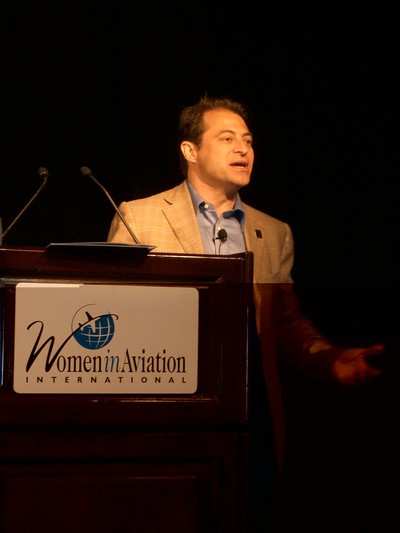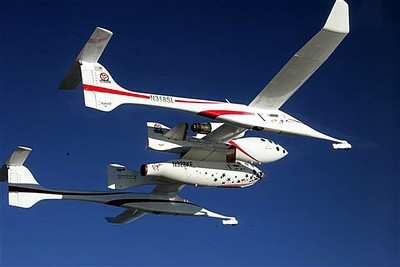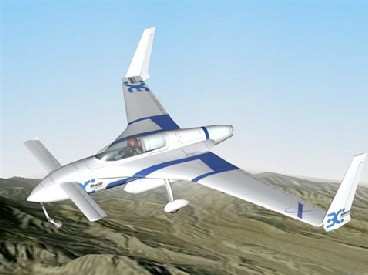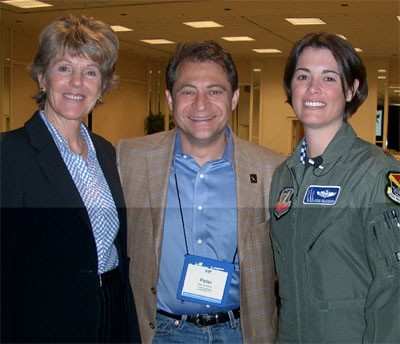Hopes To Grow Zero-G Program Significantly
by ANN Correspondent Aleta Vinas
The Women in Aviation International Conference always has top
speakers in the aviation field, and the messages these speakers
impart to the audience have no time limit. So, even though the WAI
conference is over for this year (start making plans for Atlanta
(GA) February 26 - 28 2009) the speakers' words are worth
repeating.

Dr. Peter Diamandis was born in the Bronx, and while other kids
played stickball, Diamandis was designing rockets. In 8th grade he
took 1st Prize in the Estes rocket design contest. Since age 9
becoming an astronaut was his passion. He attended Massachusetts
Institute of Technology (MIT) and received an undergraduate degree
in Molecular Genetics and graduate degree in Aerospace Engineering.
Harvard Medical School was next, and Diamandis added M.D. to his
name.
Realizing his chances were "1 in 1,000" of becoming a NASA
astronaut, Diamandis set out to find a way to travel into space
another way. "I made a commitment to do it privately," Diamandis
told his audience at WAI last week.
While reading The Spirit of St. Louis, Diamandis latched onto
the fact Charles Lindbergh flew his solo flight for the $25,000
Ortieg Prize. "With that in mind I put together a prize," Diamandis
said. "I wanted a new generation of private spaceships that I can
fly and that you can fly."
He wanted private enterprise, not governments to come in and
win. The $10 Million purse was enough to attract private interest
in the challenge. A three person spaceship would allow for a pilot
and two paying passengers, and the altitude requirement was lowered
from 100 miles to 100 kilometers -- "knowing full well most
Americans wouldn't know the difference between the two anyway,
unfortunately," joked Diamandis.

Two flights in two weeks was the goal. Twenty six teams
competed... and as we know, Scaled Composites took home the
inaugural X-Prize in 2004.
"We started making headlines" Diamandis noted "And we decided
afterwards to take the X Prize concept forward" Planning has
started on $300 - $500 billion in prizes in the next five years in
areas such as space, underwater, life sciences (including cancer),
energy and the environment.
The Google X Prize was announced last September. "A $30 million
private race to the moon," Diamandis called it. Competitors must
build a robot, land it on the moon, send back video and photos,
travel 500 meters and send more videos and images back to Earth.
Over 650 registration requests from 60 countries have been received
within these short six months. Coupled with the Google X Prize and
the future X Prize's will be an educational component. Students can
follow the team's progress via the internet and get involved.

"Hopefully we'll be launching competitions in parallel at the
high school and junior high school level," Diamandis said. "To get
the kids excited."
To those who believe the money could be better spent on Earth,
Diamandis has a few words. "As we move into space we'll be
developing technologies and be able to gain access to resources.
Frankly if we're able to mine asteroids in deep space instead of
strip mining the Earth, I think the net benefit will be much better
to Earth. Everything we hold of value on Earth, metals, minerals,
energy, real estate are in infinite quantities in space. I think
space represents vast resources that can help humanity move off the
planet and live higher standards of living. I think it's not only
necessary but inevitable and will be a net benefit to the
environment."
While watching the Apollo missions on television Diamandis
"always wondered growing up as a kid where this zero gravity room
was." In 1993, Diamandis partnered with astronaut Dr. Byron K.
Lichtenberg and NASA engineer Ray Cronise. Convinced that the
public would gravitate to the opportunity to experience Zero-G,
they took their idea to the FAA.
According to Diamandis, after the presentation the FAA response
was "You want to do what?" Finally, after 11 years of meeting with
lawyers, Zero-G took off. "Make sure you are doing what is
absolutely, passionately in your heart," Diamandis said "I
guarantee you if Zero-G was not passionately in my heart it would
not have happened." Zero-G recently won a contract to provide NASA
with zero gravity services, as the space agency's official
commercial provider.
Education is currently Zero-G's single largest market, flying
students and teachers. In 2005, Zero-G initiated a program to fly
the top math and science teachers. Diamandis is "hoping to grow
that program significantly."
"There's a complete shortage of people in math, science and
technology." Diamandis acknowledges. With the teachers in Zero G
program (coupled with Northrop Grumman) Diamandis is "giving the
teachers a chance to become heroes in the classroom, with their
flightsuits and videos." It gives the student a first hand look at
the aerospace field and ignite a passion for it when they see their
teacher and hear the experiences.
Diamandis notes today's roll models are people like Britney
Spears and Paris Hilton. These are the stories in the media.
Diamandis imagines our engineers and scientists being shown as the
heroes instead.

At WAI, Diamandis announced his intent to create a program to
fly the top 500 female high school or junior high school students.
Diamandis envisions the local congressmen and senators meeting the
flight (with an all female crew) afterwards and having media
present and being broadcast around the globe. With the right
sponsorship, Diamandis hopes to announce the program at a future
Women in Aviation Conference. "Women can go into space and lead
this arena as well," Diamandis stated.
Not being satisfied with sending rockets into space, Diamandis
also talked about the fledgling Rocket Racing League (RRL). "We are
defining a brand new sport," said Diamandis. Somewhat bored by the
standard Indy car race, Diamandis envisioned a new kind of motor
sport. "For me, putting a rocket engine on anything seems like a
very natural thing to do."
Partnering with a friend, Diamandis gave an overview of the RRL.
"We're developing a new set of vehicles called X-Racers." The X
Racers will be rocket powered, delta wing, canard, single pilot
vehicles. Ten racers will compete a mile up, with the course about
two miles by half a mile right in front of the spectators.

The engines have been developed and are being tested. "We're
hoping this Spring, early Summer to have our first public flight."
Diamandis revealed. "Then we'll be rapidly starting to build
vehicles so by the time X Prize Cup hits next Fall/Winter we can
have the first competitions." Diamandis admits being behind
schedule, but "we need to make sure it's safe".
While Diamandis has not yet gone into space, as co-founder and
managing director of Space Adventures he has helped five civilians
experience space travel. Space Adventures work with the Russians,
using the Soyuz spacecraft. A sixth civilian is currently in
training.
Diamandis has also had a hand in some lesser known ventures
which also cover aviation/aerospace. Angel Technologies
Corporation, Students for the Exploration and Development of Space
(SEDS), Starport.com and Space Generation Foundation to name a few.
The International Space University may be one of the better known
"lesser" ideas.
Diamandis has earned a "few" awards along the way as well. In
2003 there was the World Technology Award for Space. In 2006,
Diamandis snagged the Heinlein Award (inaugural year), The
Lindbergh Award, the Wired RAVE award and the Neil Armstrong Award
for Aerospace Achievement and Leadership. He has twice received the
Aviation & Space Technology laurel.

"I live in the space business" says Diamandis. Speaking to the
primarily female audience at WAI, Diamandis appealed to the women
to give a space career a try. "I can tell when I'm in a space
meeting because it's all guys," Diamandis said, "and that
sucks."
On a happier note, Diamandis adds "It is an exciting time right
now. We can do now with small groups what only nations could do
before. With that capability comes the chance to really do
incredible and amazing things."
With his personal motto of "The best way to predict the future
is to create it yourself!" Diamandis has made his words a
reality... and hopes the rest of us will follow suit, most
especially the ladies.
 Aero-News: Quote of the Day (05.15.25)
Aero-News: Quote of the Day (05.15.25) NTSB Final Report: Avia Stroitel AC-5M
NTSB Final Report: Avia Stroitel AC-5M ANN's Daily Aero-Linx (05.15.25)
ANN's Daily Aero-Linx (05.15.25) Airborne 05.09.25: Frecce Tricolori MidAir, A6M3 Zero Returns, Houthis Bombed
Airborne 05.09.25: Frecce Tricolori MidAir, A6M3 Zero Returns, Houthis Bombed ANN's Daily Aero-Linx (05.16.25)
ANN's Daily Aero-Linx (05.16.25)








